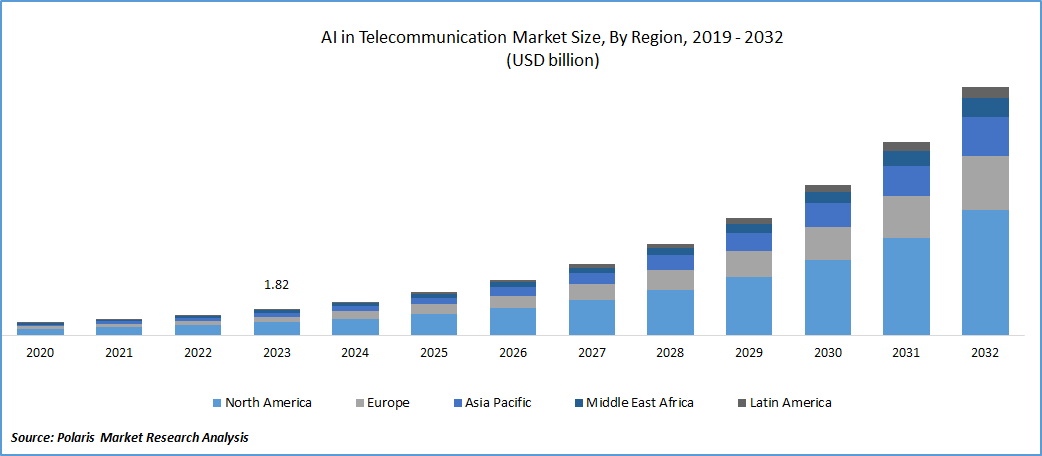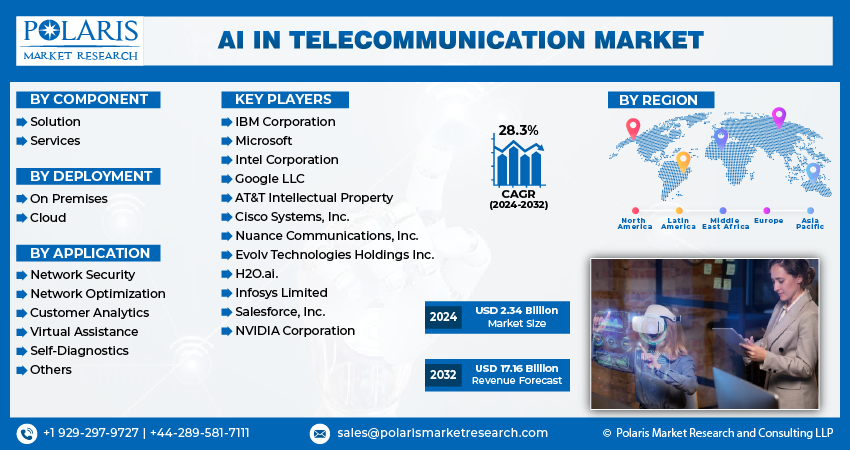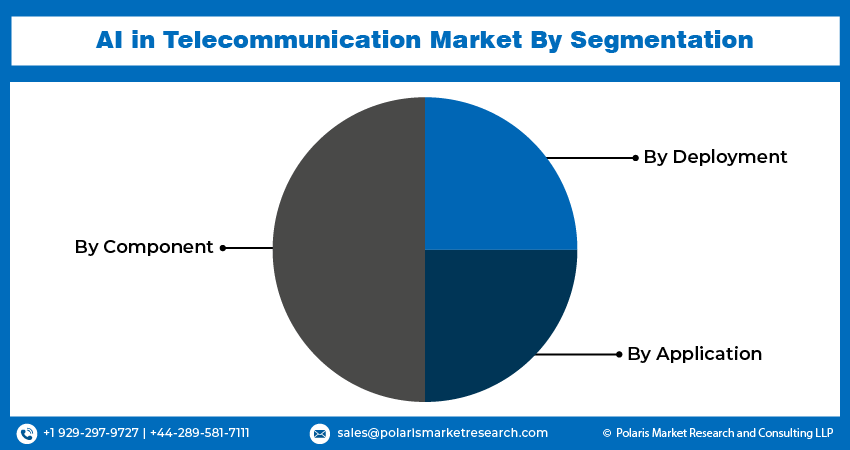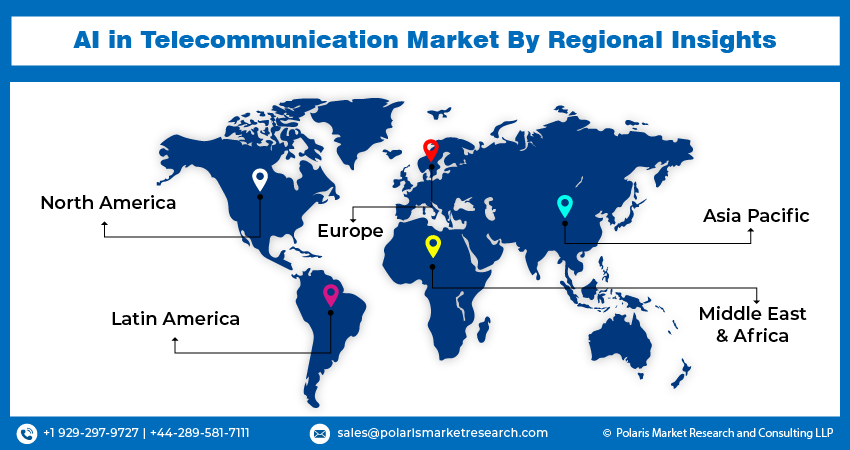
AI in Telecommunication Market Share, Size, Trends & Industry Analysis Report
By Component, By Deployment Mode, By Application (Network Security, Network Optimization, Customer Analytics, Virtual Assistance, Self-Diagnostics); By Region; Segment Forecast, 2025 - 2034
- Published Date:Jun-2025
- Pages: 130
- Format: PDF
- Report ID: PM4234
- Base Year: 2024
- Historical Data: 2020-2023
The global AI in Telecommunication Market was valued at USD 2.5 billion in 2024 and is anticipated to grow at a CAGR of 24.30% from 2025 to 2034. Network optimization and customer service automation are key growth enablers.
The telecommunications sector is witnessing rapid growth in the integration of artificial intelligence (AI) across various facets of its operations, particularly in enhancing customer experience and ensuring network reliability. AI technologies, such as chatbots and virtual assistants, play a pivotal role in addressing installation, maintenance, and troubleshooting support requests. These virtual assistants are instrumental in automating responses to support claims, leading to enhanced customer satisfaction and reduced operational costs. For instance, Vodafone significantly improved customer experience by 68% with the introduction of its TOBi chatbot, which efficiently handles customer queries.
The AI in telecommunication market report is a comprehensive assessment of all the opportunities and challenges in the industry. It covers all the recent innovations and major events in the industry while shedding light on the key market features such as CAGR, supply/demand, cost, production rate, and consumption. Along with that, the study offers a thorough analysis of the key market dynamics and the latest trends to help businesses develop strategies that will drive AI in telecommunication market growth.

To Understand More About this Research: Request a Free Sample Report
A telecommunications company with numerous call center agents developed fundamental AI models for forecasting and schedule optimization. The generated dashboards led to a significant improvement of 10 to 20 percent in overtime costs and more effective utilization of staff, resulting in an enhanced customer experience. Furthermore, the time needed by workforce management to handle forecasting and scheduling was reduced by half. The company also achieved 30 percent greater flexibility in worker allocations across various locations and job types, thanks to centralized scheduling spanning multiple business units.
The rise of Over-The-Top (OTT) services, particularly in video streaming, has significantly changed how audio and video content is distributed and consumed. The increasing number of consumers opting for OTT services has created a substantial demand for bandwidth. Handling the escalating traffic from these services poses a significant operational challenge for the telecommunications industry, leading to high operational expenditure (OpEx). AI plays a crucial role in mitigating these costs by reducing the need for extensive human intervention in network configuration and maintenance. Automation further accelerates processes, allowing telecom companies to onboard customers swiftly and introduce new services within shorter timeframes.
In the artificial intelligence value chain, system integrators, and infrastructure developers play crucial roles. Original Equipment Manufacturers (OEMs) select suitable system integrators based on their expertise, experience, and resources to offer comprehensive customer support and predictive maintenance. Service contracts with manufacturers provide various advantages to application industries, including support in design, integration, and delivery processes. Factory-trained field technicians are instrumental in installing and configuring these solutions within the telecommunications industry.
Governments globally have recognized the transformative potential of 5G technology and are accelerating its implementation to fuel AI and automation within the telecommunications sector. The rollout of 5G is expected to catalyze digital transformation, enabling the integration of IoT, edge computing, and AI in wireless telecommunications. The rising need for superior services and effortless customer experiences is anticipated to propel the adoption of AI in the telecom industry. The expanding 5G networks are poised to create profitable avenues for telecom operators, enabling them to offer outsourced IT services and enterprise process automation powered by edge computing and AI.

Growth Drivers
Customer Experience Enhancement
The integration of AI in telecommunication market and automation in the telecommunications industry has the potential to enhance customer experience while simultaneously reducing operational costs. AI technologies have revolutionized the core functions of telecommunications by enabling machines to perform tasks previously handled by humans, such as determining traffic routes by analyzing network content. AI-powered chatbots and virtual assistants improve customer service by providing real-time support, resolving queries, and offering personalized recommendations.
Additionally, AI facilitates the creation of self-optimizing networks, allowing systems to adapt based on prevailing conditions within the parameters set by designers. These advancements support network operations by detecting issues like Service-Level Agreement (SLA) breaches and identifying their root causes, leading to more efficient and reliable services.
Report Segmentation
The market is primarily segmented based on component, deployment, application, and region.
|
By Component |
By Deployment |
By Application |
By Region |
|
|
|
|
To Understand the Scope of this Report: Speak to Analyst
By Application Analysis
Customer Analytics Segment Held the Largest Share
Customer analytics segment dominated the market. This growth is primarily driven by the increasing demand for real-time behavioral insights. Artificial intelligence empowers operators to gather and analyze customer data from a subscriber's intelligent perspective. This data can be applied in various ways, including targeted advertisements and personalized offers for subscribers. Additionally, operators can leverage this information to optimize networks, ensuring more efficient use of network resources.
Virtual assistance segment will grow at a significant pace. This surge is attributed to customer service automation, which leads to significant cost savings for telecom companies. In the communication industry, customer support chatbots can be efficiently trained using machine learning algorithms, enabling automation of inquiries, and directing customers to the most suitable agents.

Regional Insights
North America Accounted For the Largest Share of the Global Market in 2024
North America dominated the global market. The region's growth is bolstered by the increasing adoption of automation and AI by telecom companies for customer service and network optimization. A key factor driving this growth is the advanced telecommunications infrastructure in North America. With robust network connectivity, including high-speed internet and extensive coverage, the region provides an ideal setting for the implementation of AI solutions.
European telecom operators are focusing on AI investments to enhance their decision-making processes based on data insights. A report from the European Telecommunications Network Operators' Association (ETNO) in February 2022 highlighted Europe's substantial investments in 5G and Fiber to the home (FTTH) networks. These significant investments are expected to drive the adoption of artificial intelligence (AI) throughout the European telecom sector. Despite strict regulations, the telecom industry in Europe is anticipated to experience stable market growth across the region.
Asia Pacific will grow at a substantial pace. This is primarily attributed to the swift technological advancements occurring in emerging economies within this region. These advancements include improvements in internet infrastructure, increased smartphone penetration, and a growing tech-savvy population. Additionally, there is a rise in digitalization initiatives, supportive government policies, and a burgeoning startup ecosystem.
All these factors collectively create a conducive environment for the adoption and integration of artificial intelligence (AI) technologies in the telecommunications industry. As businesses and consumers in these economies increasingly embrace digital solutions, telecom companies are compelled to invest in AI-driven services and automation, thereby driving substantial growth in the region.

Key Market Players & Competitive Insights
Companies in the market are employing tactics like introducing new products, acquiring other businesses, and forming partnerships to expand their presence on a global scale.
Some of the major players operating in the global market include:
- IBM Corporation
- Microsoft
- Intel Corporation
- Google LLC
- AT&T Intellectual Property
- Cisco Systems, Inc.
- Nuance Communications, Inc.
- Evolv Technologies Holdings Inc.
- H2O.ai.
- Infosys Limited
- Salesforce, Inc.
- NVIDIA Corporation
Recent Developments
- In March 2025, EY launched EY.ai Telecom Agents, an AI suite using NVIDIA AI Enterprise to automate telecom contract analysis, enhance operations, reduce costs, and improve decision-making across finance, networks, and customer service.
- In June 2023, Amdocs, introduced Amdocs amAIz, a telco generative AI framework. This cutting-edge solution incorporates carrier-grade architecture and utilizes open-source technology in combination with extensive language AI models.
- In February 2023, Bharti Airtel collaborated with NVIDIA to develop an AI solution aimed at enhancing customer experiences for all inbound calls received at its contact center.
- In September 2022, Amazon Web Services (AWS), & SK Telecom, teamed up to create a new set of computer vision services. This collaboration streamlines and enhances the development, implementation, and expansion of computer vision applications. As a result, it improves productivity, equipment maintenance, and facility safety for customers, all while reducing costs.
- In October 2022, Nokia, Introduced an AI maturity assessment tool. This tool is designed to help communication service providers develop and execute impactful AI strategies.
- In November 2022, American Tower Corporation announced a strategic partnership with PowerX. The goal is to implement PowerX's artificial intelligence (AI) solutions in Africa's telecommunications sector, aiming to improve energy efficiency and environmental benefits by optimizing energy usage at tower sites.
- In July 2022, Actifai, collaborated with the CSG, with the goal of transforming customer acquisition strategies for cable and telecommunications service providers. Their collaboration introduces an AI-powered offer recommendation solution designed to enhance customer experiences.
AI in Telecommunication Market Report Scope
|
Report Attributes |
Details |
|
Market size value in 2025 |
USD 3.1 billion |
|
Revenue Forecast in 2034 |
USD 20.8 billion |
|
CAGR |
24.30% from 2025 – 2034 |
|
Base year |
2024 |
|
Historical data |
2020 – 2023 |
|
Forecast period |
2025 – 2034 |
|
Quantitative units |
Revenue in USD billion and CAGR from 2025 to 2034 |
|
Segments Covered |
By component, By deployment mode, By Application, By Region |
|
Regional scope |
North America, Europe, Asia Pacific, Latin America, Middle East & Africa |
|
Customization |
Report customization as per your requirements with respect to countries, regions, and segmentation. |
Explore the market dynamics of the 2025 AI in Telecommunication Market share, size, and revenue growth rate, meticulously examined in the insightful reports crafted by Polaris Market Research Industry Reports. The analysis of AI in Telecommunication Market extends to a comprehensive market forecast up to 2034, coupled with a retrospective examination. Avail yourself of a complimentary PDF download to sample this in-depth industry analysis.
Browse Our Top Selling Reports
Bakery Premixes Market Size, Share 2024 Research Report
Collagen Market Size, Share 2024 Research Report
Aerospace Riveting Equipment Market Size, Share 2024 Research Report
Latin America Industrial Pumps Market Size, Share 2024 Research Report
FAQ's
Component, deployment, application, and region are the key segments in the AI in Telecommunication Market
The global AI in telecommunication market size is expected to reach USD 20.8 billion by 2034
The global AI in telecommunication market and is expected to grow at a CAGR of 24.30% during the forecast period.
North America regions is leading the global market
Customer Experience Enhancement are the key driving factors in AI in Telecommunication Market
